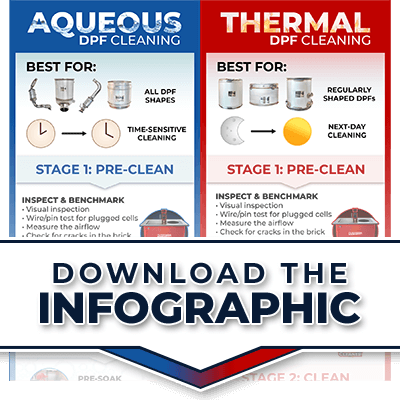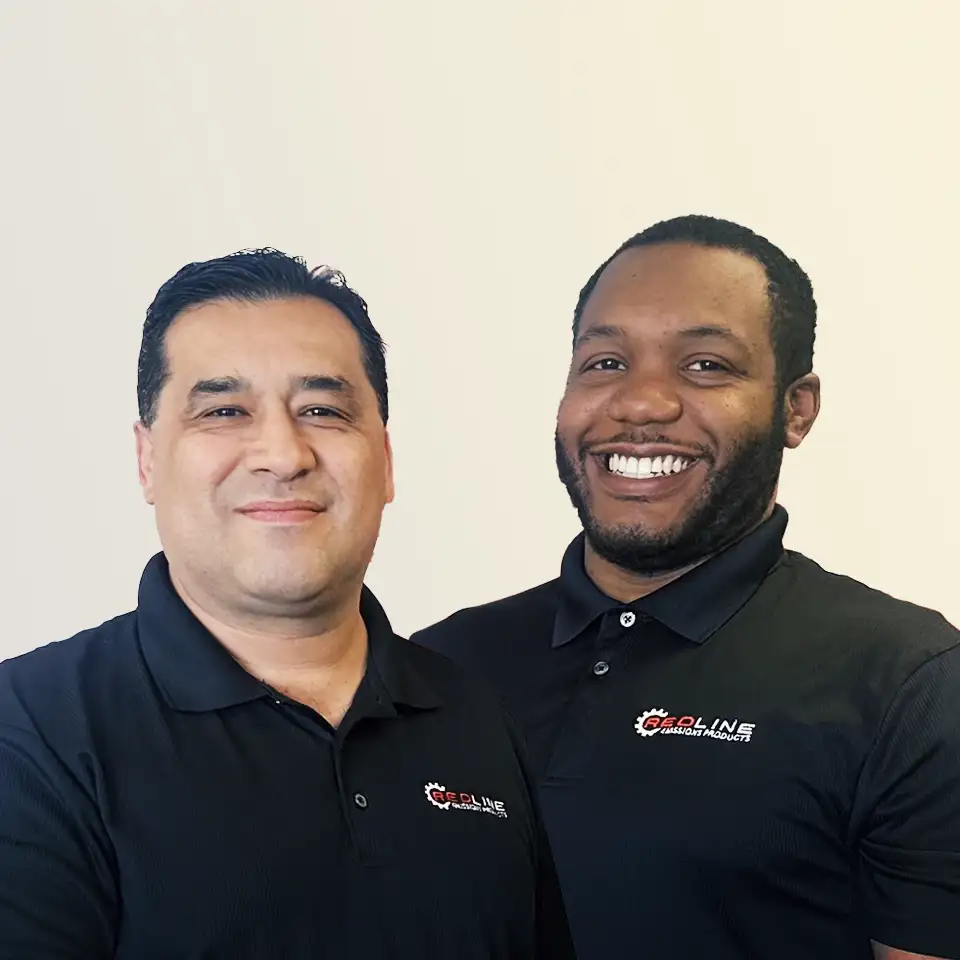Page Section – Quick-links
Choose your own path to DPF Cleaning independence
Choose your own path to DPF Cleaning independence
There are 2 DFP Cleaning methods we have systems for: Thermal and Aqueous.
Each method has different strengths and benefits.
Sometimes our customers decide to go with both cleaning methods – leveraging the combined strengths to cover a wider range of scenarios. We show you how, check out this Case Study.
Consider each DPF Cleaning option to see which is a good fit for your fleet. Ask yourself some of the key questions we ask to better understand each customer’s situation.
Then get educated on some common DPF Cleaning topics such as why and how often.
Finally, learn about Filtertrak, a powerful software tool to easily manage all your DPF Cleaning service data in one place
Let’s get started…
There are 2 distinct DFP Cleaning methods we have systems for: Thermal and Aqueous.
Each method has different strengths and benefits.
Start by considering some key questions and explore each DPF Cleaning process to help decide which one is for your fleet.
Then get educated on some common questions about DPF Cleaning such as why and how often.
Finally, learn how you can use Filtertrak, a powerful software tool to easily manage all your DPF Cleaning service data in one place
Let’s get started…
Which DPF Cleaning process is right for your fleet?
We can help you answer this question based on the unique needs of your fleet. Factors to consider include the types of filters your trucks have, duty cycles, driving conditions, off-road vs on road, etc. Whatever your needs are we’ve got you covered.
Explore the 2 main types of DPF Cleaning systems below.
FAQ: DPF Cleaning Systems
Choosing the Right System for Your Fleet:
Q: Which system is faster for a single filter?
A: For the fastest possible turnaround, our Aqueous system is the clear choice. It can clean and dry a filter in as little as 2 hours, minimizing vehicle downtime.
Q: Which system is better for cleaning a large volume of filters?
A: This depends on your shop’s workflow:
- The Aqueous system is ideal for a continuous flow, cleaning up to 20 filters in an 8-hour shift.
- The Thermal system is perfect for batch cleaning. You can bake 6 or more filters overnight, having them ready for the next day.
Q: What is the best method for cleaning odd-shaped or tapered filters?
A: The Aqueous system easily handles non-standard filters. It uses custom adapters to ensure a perfect seal without ever needing to cut the filter open.
Capabilities, Safety, and Special Cases:
Q: Can I clean filters soaked with oil, coolant, or fuel?
A: Yes. Our Thermal oven features a special dry-out cycle to safely remove these liquids. After the cycle, the filter can be cleaned using either the Thermal or Aqueous method.
- Please Note: While the filter itself can be cleaned, a catalyst saturated with oil or coolant may be permanently damaged and unable to regenerate.
Q: How safe is the Thermal DPF Oven during operation?
A: The Filtertherm DPF Oven was designed with three key safety features:
- Cool-Touch Exterior: A ventilated air pocket keeps the outer surface safe to touch.
- Password-Protected Access: Ensures only trained, authorized technicians can operate the oven.
Automatic Temperature Lock: The door is electronically controlled and will not open until the internal temperature is at a safe level.
Not sure which DPF cleaning process is right for you?
Check out this infographic to help you compare both DPF Cleaning methods. Also, see where each piece of equipment fits into the flow and what it does.
Or you can get the best of both worlds, like these guys did. Read their story!
Get educated on DPF Cleaning best practices
Having the right DPF Cleaning Equipment for your fleet is just the beginning.
You don’t need to “reinvent the wheel”
A key element is also using the correct cleaning process. Establishing and following the right process for each filter is the best way to ensure consistent, predictable results for your fleet.
Without this, you’re at the mercy of external DPF cleaning facilities. You can either hope for the best or have rock-solid confidence in your own in-house cleaning operation. Your choice.
The Filtertherm® team has spent nearly 15 years cleaning tens of thousands of filters. We’ve extensively fine-tuned and tested the process in our own DPF Cleaning facilities.
We are happy to share this knowledge with you and can even provide training for your technicians.
Why Clean your own DPFs?
A DPF (diesel particulate filter) is designed to catch & oxidize soot (unburned fuel/lube oil) and turn it into ash. The ash is pushed to the bottom of the filter and stored there. Over time it builds up and requires cleaning. With the cost of some new DPFs soaring to over $12,000, routine maintenance is key.

Being proactive & in control of your fleet service intervals can drastically decrease downtime and service expenses. At the same time increasing operational efficiency and profit. Thus, it’s important to regularly inspect, clean, and track your filters, not only to preserve the functionality of each filter but to save on fuel and protect your engines.
How often should you clean your DPFs?
There have been many myths and misconceptions about aftertreatment systems. Some people think you can just ignore them until the dreaded “derate”. Others think you can base all emissions servicing on the OE specs alone. That’s just not the case in the real world.
OE service recommendations are between 200,000 – 300,000 miles, or 4500 hours – whichever comes first. Aftermarket manufacturers of DPFs recommend cleaning at 50,000 – 70,000 miles, or 1,000 hours – whichever comes first. These numbers are generally overly optimistic and presume perfect operating conditions.
Based on our experience, Filtertherm® recommends servicing your DPF at least once a year. Removing the soot regularly will help extend the life and performance of your fleet’s aftertreatment systems and engines. Hardened ash build-up in the system restricts the flow and often causes unnecessary engine issues or failures.
It’s vital to establish a maintenance schedule that also takes into consideration the real-world driving conditions of the vehicle. Trucks that are run in stop-and-go traffic or high idling situations often need dpf cleanings at closer intervals.
Proper DPF maintenance is key to a healthy truck & in turn a HEALTHY FLEET.
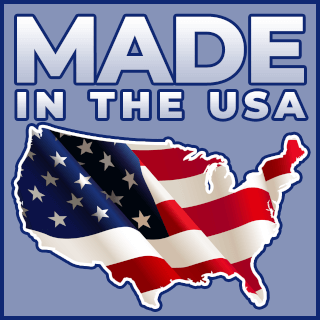
Designed & Built in the USA!
Designed and Built in the USA
Turn DPF Service Data into Fleet Savings
– Spot Problems Early: Use data to discover upstream engine issues or identify problematic trucks before they lead to costly downtime.
– Visualize Service Quality: Access before/after photos, flow test results, and vehicle-specific data from any device.
– Optimize Your Maintenance: Make data-driven decisions about cleaning schedules and filter lifespan to maximize your fleet’s efficiency.”
– Prove Compliance: Generate professional, detailed service reports to validate maintenance and warranty claims.
Get Your First Year of FILTERtrak™ FREE! A $1,200 value, included with any Filtertherm DPF cleaning package.
Don’t just clean your filters—control your fleet’s aftertreatment program.
Contact our sales team to to learn more.
Diesel Emissions System Infographic
An overview of the aftertreatment system, showing the path of exhaust gas from the engine to the tailpipe.
From Engine
To Tailpipe
DOC
(Inlet)
DPF
SCR
(Outlet)
Sensor
Sensor
Sensor
Pressure
Pressure
Sensor
Sensor
Sensor
Get the Premier DPF Cleaning solution for your FLEET.
Give us a call. Get Answers.
Use our ROI tool to see how quickly this investment can save your fleet time and money. Financing is now available. Check it out!
Call or email to schedule a meeting with our expert Sales Team. Anthony and Nadjara are happy to help you.
